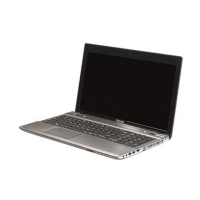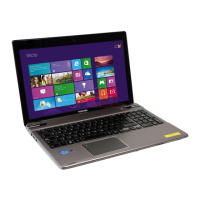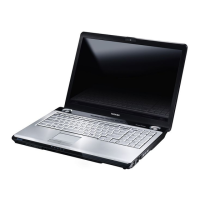
Do you have a question about the Toshiba Satellite P855 Series and is the answer not in the manual?
| Webcam | HD Webcam |
|---|---|
| Processor | Intel Core i3/i5/i7 |
| RAM | Up to 8GB DDR3 |
| Storage | 1TB HDD or 128GB SSD |
| Display | 15.6" HD (1366x768) |
| Graphics | NVIDIA GeForce GT 630M or Intel HD Graphics 4000 |
| Operating System | Windows 7 or Windows 8 |
| Optical Drive | DVD SuperMulti drive |
| Wireless | Wi-Fi 802.11 b/g/n |
| LAN | 10/100/1000 Ethernet |
| HDMI | Yes |
| Audio | Built-in stereo speakers |
| Ports | headphone/microphone combo jack |
| Battery | 6-cell lithium-ion |
Instructions on ensuring proper ventilation to prevent overheating and potential damage.
Guidelines for setting up a safe and conducive environment for computer operation.
Lists hardware, documentation, and software items included with the computer.
Guidance on initial computer setup, including OS installation and safety manual review.
Illustrates and describes connecting the power cord to the AC adapter using 2-pin or 3-pin plugs.
Illustrates and describes connecting the DC output plug from the adapter to the computer's power input.
Steps for powering on the computer for the first time and initial setup.
Explains how to properly shut down the computer, saving data and closing applications.
Describes the Sleep Mode for interrupting work and resuming later, with aircraft safety notes.
Explains how to configure automatic Hibernation Mode based on power button or lid closure.
Identifies components on the front of the computer when the display is closed.
Details the DC input jack for connecting the AC adapter for power and charging.
Describes the LAN jack for connecting to a wired network and Ethernet standards.
Explains the USB 3.0 ports for connecting peripherals and their backward compatibility.
Describes the HDMI out port for connecting to external displays via HDMI cable.
Explains the VGA port for connecting analog monitors.
Explains the function of the rechargeable lithium-ion battery pack for portable power.
Identifies the slot for installing or removing memory modules to expand system memory.
Details the web camera's functionality for video recording, chatting, and conferencing.
Provides specifications for the LCD display, including resolution and brightness behavior on battery vs. AC power.
Specifies the distance and angle for effective remote controller operation.
Instructions on how to use the touch pad for pointer control and its buttons.
Describes the twelve function keys and their behavior, distinct from the FN key.
Provides instructions and illustrations for correctly swiping a finger on the sensor to minimize authentication failures.
Lists the various formats supported by DVD Super Multi, Blu-ray Combo, and Blu-ray Writer drives.
Lists important notes and limitations for using the TOSHIBA VIDEO PLAYER software.
Lists important notes and limitations for using the TOSHIBA Blu-ray Disc Player software.
Lists critical safety warnings and precautions for viewing 3D content.
Details the Wireless LAN compatibility, standards (IEEE802.11), and features like channel selection and encryption.
Provides step-by-step instructions for connecting the computer to a wired LAN.
Provides essential precautions for handling and caring for memory media cards to prevent damage.
Explains the Peak Shift Control utility for reducing power consumption during peak demand periods.
Explains the HDD protection feature that uses sensors to prevent damage from shocks.
Explains the hidden recovery partition for system recovery options in case of problems.
Explains how operating capability and battery status are affected by AC adapter connection and battery charge levels.
Explains battery types, usage, recharging methods, and handling precautions.
Explains that battery packs are consumable and need replacement, detailing removal and installation procedures.
Describes the three main power-up modes: Shut Down, Hibernation, and Sleep.
Provides guidelines for effectively diagnosing and resolving computer problems, emphasizing observation and documentation.
Lists common hardware and peripheral areas that may cause problems.
Discusses power-related issues, including battery as primary source and intelligent power supply.
Discusses battery troubleshooting, focusing on the DC IN/Battery indicator.
Suggests checking software remapping and contacting support if keyboard output is garbled.
Troubleshooting steps for boot failures, including checking optical drive discs and boot priority settings.
Troubleshooting common Touch Pad issues, including unresponsiveness, double-tapping, and pointer speed/sensitivity.
Steps to ensure Wireless LAN function is on and contact LAN administrator for persistent problems.
Directs users to the TOSHIBA technical support website for hardware-related problems.
Provides the physical size specifications of the computer in millimeters.
Discusses CPU performance variations based on operating conditions and product configuration.
Warns about potential interference and performance issues when using Wireless LAN or Bluetooth devices simultaneously.









